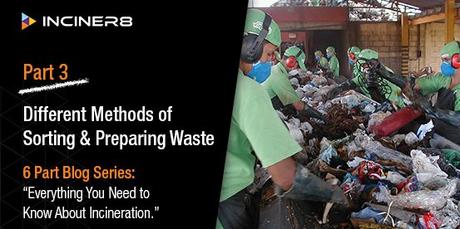
Why is Sorting Waste Important?
There are many different ways that waste recovery facilities sort and prepare waste. On this scale, machinery is often used to make the process more efficient. Waste sorting municipal waste often starts manually at the household.
It is important that waste is sorted before it moves onto the next process of treatment or disposal. This will determine the preferred disposal method suited to the waste stream is chosen, resulting in less waste ending up in landfills.
The common methods of sorting and preparing waste are as follows:
Manual Seperation
Bulky items such as large pieces of wood, rocks, long pieces of cloth, etc. are removed by hand before mechanical processing begins. Equipment involved in manual separation usually includes a sorting belt or table. Hand picking of refuse is perhaps the most prevalent MSW handling technique; it is also the only technique for removal of PVC plastics.
Hand separation is time consuming and labour intensive - however, it does allow for the sorting of waste in a manner which contributes towards having better separation of waste and the recovery of recyclable materials.
Air Seperation
In this method, fans are used to create a column of air moving upwards. Low-density materials are blown upwards, and dense materials fall. The air carrying light materials, like paper and plastic bags, enters a separator where these items fall out of the air stream. The quality of air separation depends on the strength of the air currents and how materials are introduced into the column. Moisture content is also critical as water may weigh down some materials or cause them to stick together.
Size Reduction
There are two types of devices are commonly used for this process: hammer mills and shear shredders. Hammer mills consist of rotating sets of swinging steel hammers through which the waste is passed, and shear shredders are used for materials that are difficult to break apart such as tires, mattresses, plastics, etc. The hammers need frequent resurfacing or replacement. Both are energy and maintenance intensive. Hammer mills shatter items such as fluorescent light bulbs, compact fluorescent lamps, and batteries.
Hammer Mill: Sheer Shredder:Another methodology for reducing the waste size is to place the waste into a centrifugal shredded system which reduces the original volume by 80% and the weight by 50%. This allows the physical particle size to be reduced, but more importantly reduce the moisture content of the waste.
Trommel Screening
A trommel screen, also known as a rotary screen, is a mechanical screening machine used to separate materials, mostly solid-waste processing industries. It consists of a perforated cylindrical drum that is normally elevated at an angle at the feed end. For an inclined drum, objects are being lifted and then dropped with the help of lifter bars to move it further down the drum; otherwise, the objects roll down slower. Furthermore, the lifter bars shake the objects to segregate them. Lifter bars will not be considered in the presence of heavy objects as they may break the screen.
Physical size separation is achieved as the feed material spirals down the rotating drum, where the undersized material smaller than the screen apertures passes through the screen, while the oversized material exits at the other end of the drum. In municipal solid waste industry, trommel screens classify sizes of solid waste. By removing inorganic materials such as moisture and ash from the air-classified light fraction segregated from shredded solid waste, trommel screening improves the fuel- derived solid waste.
Drying
Drying process reduces the moisture content of waste and prevents the leachate production- which could seep into the water if the waste were disposed of in land fill or stored in an open area over long periods of time.
Dried materials tend to be inactive biologically and are easier to store. This results in a homogeneous refuse-derived fuel (RDF). Any partially decayed waste should be dried either under the sun, by hot air, or by a combination of both if applicable.
Although the option to air dry in the UK is very limited for customer/ clients, for those who operate in different parts of the world, this could be considered as part of the initial feasibility study.
This important step in the process differs in each facility depending on the investment or land availability. Solar drying is not possible during rainy seasons and most facilities run at a fraction of their capacity during the rainy season, sending most of the waste to landfills. Mechanical drying, on the other hand, requires significant amounts of energy that could easily render RDF plants unprofitable without huge government subsidies.
Ferrous Metal Separation (Magnetic Separation)
Electro-magnets are used in this step so they can be switched on or off to allow removal of collected metals. However, not all metals can be removed by magnets. Non-ferrous metals do not have iron and do not respond to the magnetic field.
Stainless steel, copper, and aluminium, for example, are only weakly magnetic or are not magnetic at all. A further limitation of this technique is that small magnetic item will not be picked up if they are buried in non-magnetic materials and larger magnetic items can drag unwanted items like paper, plastic, and food waste along with them.
Non-ferrous Metal Separation (Eddy Current Separator)
The image demonstrates a separation of non-ferrous metals from inert materials in an eddy current separator. Eddy current separators, or non-ferrous separators, use the current induced in little swirls ("eddies") on a large conductor and separate non-magnetic metals.
An eddy current is a swirling current set up in a conductor in response to a changing magnetic field. If a large conductive metal plate is moved through a magnetic field which intersects perpendicularly to the sheet, the magnetic field will induce small "rings" of current which will actually create internal magnetic fields opposing the change.
Eddy current separators handle high capacities because the conveyor belt separates and carries away non-ferrous metals continuously and fully automatically. An important factor for good separation is an even flow of material, supplied by a vibrating feeder or conveyor belt, for example, to provide a uniform mono-layer of materials across the belt. It is especially important with smaller fraction sizes.
This blog is of a 6 part series on "Everything You Need to Know About Incineration", brought to you by our expert technical team at INCINER8.
Click the links below to read:

